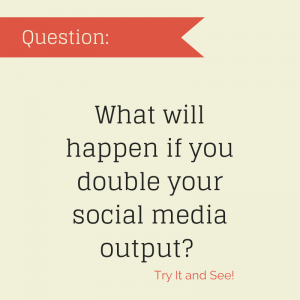If your organization has gotten into a good social media routine, monitoring channels, posting content regularly and seeing results, maybe it’s time to double up on your content output.
What do I mean by doubling up? If you’ve been posting two to three times per week on your channels, try doubling your output for a specified time period to see what effect this can have on your engagement and followers.
Here are three recent examples from my client channels.
Increasing Twitter Action
A health care client went from posting 2-3 times per week on Twitter. When that schedule was adjusted to a daily posting schedule, the results were immediate. In the chart below, you can see the difference in activity from one month to the next.
|
Clicks |
Mentions |
RTs |
New Followers |
|
| Month 1 |
51 |
20 |
13 |
7 |
| Month 2 |
215 |
39 |
20 |
50 |
Facebook Contest
A nonprofit client doubled their content output during a Facebook voting contest, which really changed their footprint during and after the contest. The table below shows the regular Facebook insights from that time period. The contest was held in Weeks 3-6. Notice the halo effect in week 7. If you compare week 8 with week 1, the page had a significantly higher reach overall.
|
Timeframe |
New Likes |
Talking About |
Weekly Reach |
|
Week 1 |
6 |
12 |
297 |
|
Week 2 |
2 |
23 |
580 |
|
Week 3 |
10 |
69 |
944 |
|
Week 4 |
19 |
65 |
993 |
|
Week 5 |
4 |
107 |
817 |
|
Week 6 |
59 |
124 |
13554 |
|
Week 7 |
37 |
78 |
14248 |
|
Week 8 |
7 |
56 |
1551 |
Double Posting on Facebook
A local brand accelerated their Facebook posting schedule to twice per day due to a large number of events during a holiday period. Prior to doubling up, their average monthly engagement was 7%. During the accelerated posting month, their engagement rate soared to 17%. They also gained fans and over the next few months, their engagement rates were 11-12%.
Think how you might double up your social media posting schedule but more importantly, see what happens to your channel and analyze the results.

